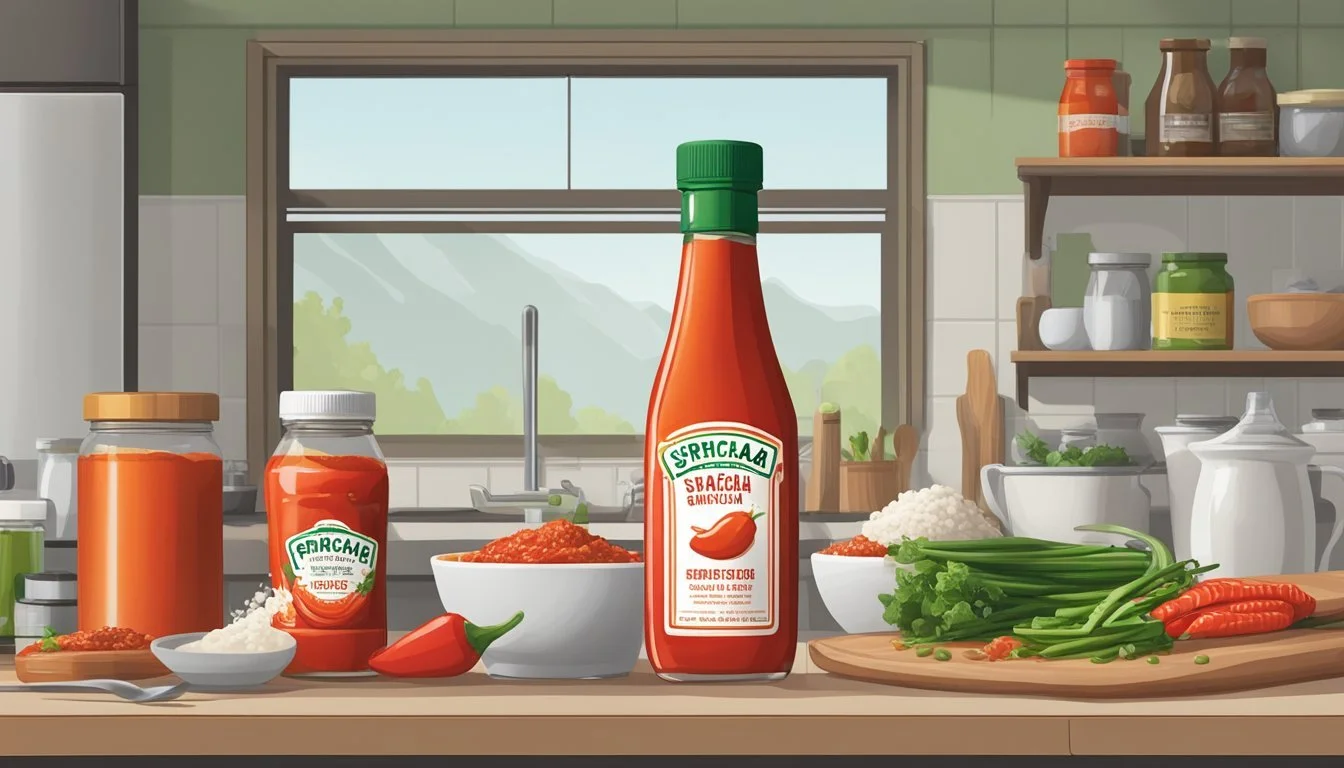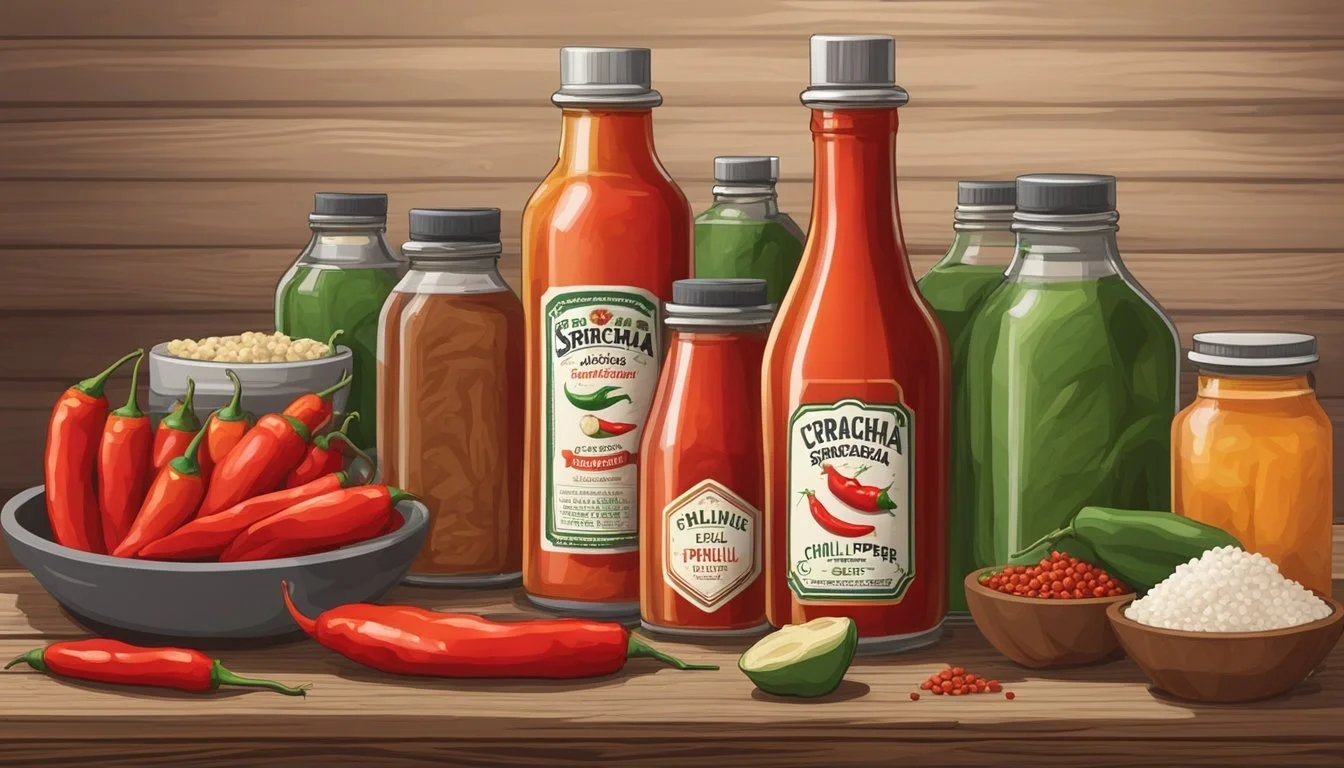Does Sriracha Expire?
Understanding Shelf Life and Storage
Sriracha, a beloved hot sauce that combines chili peppers, garlic, sugar, salt, and vinegar, is a staple in many kitchens around the world. With its unique flavor and versatility, it enhances a variety of dishes. But does Sriracha expire? The answer is that while Sriracha does have a best before date, an unopened bottle can remain good for at least two years past that date if stored properly.
Once opened, Sriracha typically retains its quality for about six months at room temperature, and up to a year when kept in the refrigerator. The preservation qualities of its ingredients, such as vinegar and salt, contribute to its long shelf life. Despite its durability, it’s essential to check for signs of spoilage, like changes in taste or the appearance of mold, to ensure it’s still safe to consume.
Understanding Sriracha
Sriracha is a widely-loved hot sauce known for its spicy and tangy flavor, primarily made by Huy Fong Foods. It contains chili peppers, distilled vinegar, garlic, sugar, and salt, making it a versatile condiment in many cuisines.
Origins and Popularity
Sriracha originated in Thailand and was brought to the United States by David Tran, the founder of Huy Fong Foods. Tran began producing this sauce in 1980 in Los Angeles, and it quickly gained popularity.
The distinctive flavor and heat level make Sriracha a favorite among those who enjoy spicy foods. Restaurants, fast food chains, and home cooks widely use it to enhance the taste of various dishes, from eggs to noodles.
Main Ingredients
The primary ingredient in Sriracha is chili peppers, which provide the heat. These are typically red jalapeños. Garlic adds a robust, savory depth to the flavor, while distilled vinegar lends acidity that balances the heat.
Sugar and salt are also essential, contributing to the sauce's unique sweet and salty profile. All these ingredients are blended and aged to develop the characteristic taste that Sriracha is known for.
Shelf Life of Sriracha
Sriracha can last quite a long time, depending on whether it is opened or unopened and how it is stored. Proper storage in cool, dark places such as a pantry or fridge can significantly extend its shelf life.
Unopened Sriracha Shelf Life
Unopened Sriracha has an impressive shelf life. Typically, it can last 1 to 2 years past the "best before" date if stored properly in a cool, dark place, such as a pantry.
The ingredients in Sriracha, like vinegar and chili peppers, contribute to its longevity. However, exposure to light and air can degrade the quality over time.
There might be some change in color, often becoming darker. This color change is usually not a sign of spoilage but rather an indication of oxidation, which does not generally affect the flavor.
Always check the expiration date on the bottle. Properly storing the unopened bottle in a pantry ensures it stays fresh for as long as possible.
Opened Sriracha Shelf Life
Once opened, Sriracha should be refrigerated to maximize its shelf life. In the fridge, it can maintain its best quality for about 4 to 5 years.
If left at room temperature, the quality may decline faster, often staying good for up to 6 months.
Signs of spoilage in opened Sriracha include unusual mold growth, bad odors, or an off taste. Even though the sauce may darken over time, this does not imply it has gone bad. Instead, the primary indicators of spoilage should be monitored.
Frequent users typically finish the bottle within these timeframes, but it’s essential to keep an eye on the quality signs mentioned to ensure safe consumption.
Storage and Preservation
To maintain the best quality of Sriracha, it is vital to understand how to store it properly. Key factors include storage conditions, natural preservatives, and whether refrigeration is necessary for optimal preservation.
Proper Storage Conditions
Storing Sriracha correctly significantly extends its shelf life. It should be kept in a cool, dry place, ideally at temperatures between 50°F and 70°F (10°C to 21°C).
Exposure to air and light should be minimized, as these factors can accelerate the darkening process and degrade the sauce's quality. Ensuring that the bottle is tightly sealed will also help prevent contamination and maintain freshness.
Room temperature storage is generally sufficient, so cabinets or pantries make suitable storage locations as long as they are not exposed to direct sunlight or extreme temperature changes.
Natural Preservatives in Sriracha
Sriracha contains a blend of natural preservatives, including vinegar, sugar, and salt. These ingredients help extend the sauce's shelf life by inhibiting the growth of bacteria and mold.
Vinegar, a key preservative, significantly reduces the pH level, creating an environment that is inhospitable to most microorganisms. Sugar and salt also contribute to preservation by drawing moisture out of potential contaminant cells, thereby inhibiting their growth.
These natural preservatives make Sriracha more resilient compared to other condiments, allowing it to remain safe for consumption even after prolonged periods.
Refrigeration and Quality
While it is not strictly necessary to refrigerate Sriracha, doing so can help maintain its quality for a longer period. Refrigeration slows down the degradation processes and helps preserve the sauce's flavor, color, and texture.
However, many find that room temperature storage suffices, especially if the bottle is used frequently. If you do choose to refrigerate, ensure the bottle is securely closed to prevent moisture from entering and causing texture changes.
Refrigeration becomes more critical if the sauce has been open for an extended period or if the ambient temperatures consistently exceed the recommended storage range. Keeping it in the refrigerator can provide an extra layer of protection against spoilage.
Identifying Spoilage
Determining if Sriracha sauce has gone bad involves examining several key factors. Each factor provides specific indicators that the sauce's quality and safety might be compromised.
Changes in Appearance
A primary sign of spoilage in Sriracha is a change in color. Fresh Sriracha is typically a vibrant red, but if it starts to darken significantly, this could indicate spoilage.
Exposure to air and light can accelerate this darkening process. Additionally, if you notice any unusual discoloration, it might be best to discard the sauce. Any visible mold on the bottle or cap is a clear indication that the product has gone bad.
Alterations in Texture
The texture of Sriracha sauce can also offer clues about its condition. Normally, Sriracha has a smooth consistency.
If it becomes unusually thick, watery, or clumpy, these changes might suggest that the sauce is no longer good. Sometimes, separation of liquids is normal if it has been stored for a long period, but extensive separation and changes in texture are not. Stirring the sauce can help but should be done cautiously.
Odor and Taste
Odor can be a reliable indicator of Sriracha spoilage. Fresh Sriracha has a strong, spicy aroma. However, if the sauce develops a foul or rancid smell, it is likely spoiled.
Similarly, changes in taste are important. Sriracha should have a consistent spicy and tangy flavor. If the taste becomes off or unpleasant, it's an indication that the sauce may no longer be safe to consume. A strong or unusual sourness can also be a hint of spoilage.
Presence of Mold
Mold growth is a definitive sign that Sriracha sauce has gone bad. Mold can appear as dark, fuzzy spots on the surface, bottle cap, or inside the container.
Even a small amount of mold is a reason to discard the sauce immediately. Mold growth indicates that the sauce has been compromised and could pose health risks if consumed. Always check the entire container for such signs.
By focusing on appearance, texture, odor, and mold growth, one can effectively determine if their Sriracha sauce is still good or has gone bad. Regularly inspecting these aspects ensures the sauce remains safe to use.
Sriracha Usage Tips
Sriracha sauce is versatile, enhancing many dishes from stir-fries to snacks. Focus on keeping the sauce fresh and using it creatively for the best culinary experience.
Cooking with Sriracha
Sriracha is a fantastic ingredient for adding spice to various dishes. It’s commonly used in Asian cuisine, particularly in Thai and Vietnamese recipes. Stir-fries, soups, and marinades benefit from its chili pepper and garlic flavor. Just a spoonful can add considerable heat.
For seasoning meat, fish, or tofu, mixing Sriracha with soy sauce creates a powerful marinade. It’s also great for glazing roasted vegetables. When cooking, it’s best to add Sriracha towards the end to preserve its vibrant flavor.
Sriracha as a Dipping Sauce
As a dipping sauce, Sriracha is perfect for spring rolls, dumplings, or even pizza. It can be used straight from the bottle or as part of a more complex sauce. Mixing it with mayonnaise makes a creamy, spicy dip that's excellent for fries and sandwiches.
For an easy substitute, blend Sriracha with sour cream or Greek yogurt for a tangy, spicy dip. Freshness is key; keep the bottle tightly sealed and store it in a cool, dark place. If you notice mold or a significant change in flavor, it’s time to replace your bottle.
Safety Concerns and Food Poisoning
When consuming Sriracha, understanding the potential for food poisoning and measures to prevent contamination is essential. Follow proper storage guidelines and recognize signs of spoilage to reduce risks.
Risks of Consuming Expired Sriracha
Expired Sriracha can pose health risks, including food poisoning. Signs of spoilage such as mold, unusual odors, or changes in color indicate bacterial growth. Consuming such contaminated sauce may introduce harmful bacteria into the body.
Symptoms like nausea, vomiting, diarrhea, and fever can occur from ingesting spoiled Sriracha. Those with weakened immune systems are at higher risk for severe reactions. Always check expiration dates and inspect sauce for spoilage before consumption to avoid these health hazards.
Preventing Contamination
Proper hygiene and storage are key to preventing Sriracha contamination. Store unopened bottles in a cool, dark place and refrigerate once opened. This slows bacterial growth and prolongs the sauce's shelf life.
Always use clean utensils when serving to avoid introducing bacteria. Avoid exposure to air and light by tightly sealing the bottle after each use. By following these guidelines, one can enjoy Sriracha safely without the risk of food-borne bacteria.
Homemade Sriracha Alternatives
Creating your own version of Sriracha at home can be rewarding and offers flexibility in flavor and heat intensity. Below, the DIY process is explored in detail to help you craft your homemade Sriracha sauce.
DIY Sriracha Sauce
Homemade Sriracha involves a straightforward process that starts with fresh red chili peppers. These peppers, combined with garlic, vinegar, sugar, and salt, create the essential base.
Begin by blending the peppers and garlic into a smooth paste. To achieve the distinctive Sriracha flavor, it's crucial to ferment the mixture for several days. Fermentation can be as short as three days or as long as a week, depending on the desired depth of taste.
After fermenting, mix in vinegar and sugar, and then simmer the sauce until it reaches the preferred consistency. Strain the mixture to remove solids if a smoother sauce is desired. Store in a sterilized bottle and refrigerate for prolonged freshness.
This method not only ensures a fresh, preservative-free product but also allows for customization according to personal heat preferences and ingredient availability.





